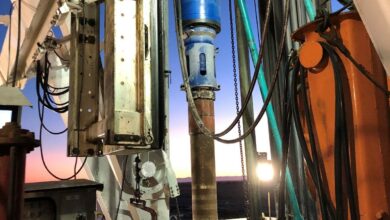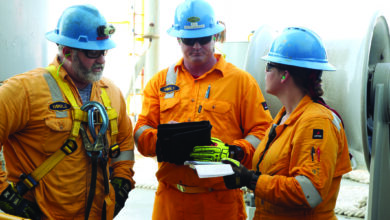Drilling & Completion Tech Digest

Nabors drills first well from fully automated land rig
Nabors Industries announced its PACE-R801 – which the company is calling the industry’s first fully automated land drilling rig – has reached total depth on its first well, a horizontal well for ExxonMobil in the Permian Basin.
XTO Energy, a subsidiary of ExxonMobil, contracted the rig to drill three horizontal wells on a test pad in Midland County, Texas, as part of its own R&D efforts. The first well was drilled to a total measured depth of 19,917 ft. Nabors and ExxonMobil do not plan to publish performance data and results.
The rig utilizes Nabors’ Smart Suite of automated drilling software with Canrig robotic systems, creating an unmanned rig floor that removes crews from red zone areas. Crew size on the rig is similar to other Nabors rigs, but their duties are different. One driller is required to supervise the operations of the rig, while others continue to perform essential tasks, such as service, maintenance, inspections and rig moves.
The configuration of PACE-R801 was built to showcase Nabors’ technologies. The featured automation, robotics and digitalization technologies used on the rig are available and operational across the Nabors fleet and those of third parties globally.
Utilization of the full suite of Nabors drilling automation software – which includes the company’s SmartDRILL and SmartSLIDE drilling automation software – have already reduced drilling time for operators by four days in the Permian and Williston Basins and shown promise to reduce drilling emissions.
Nabors is utilizing lessons learned from the development of the automated rig on other technologies that focus on safety, efficiency and the environment.
Click here to view a video of the PACE-R801 drilling in the Permian Basin.
Blockchain partnership aims for supply chain efficiencies
Kongsberg Digital and Data Gumbo announced that they have partnered to integrate GumboNet’s blockchain smart contract network into the Kognitwin software-as-a-service platform. The companies say the move will “improve supply chain efficiencies and transactional accuracy and transparency.”
The Kognitwin system enables industrial operators to integrate and contextualize data from their IT and OT systems. When deployed with automated smart contracts on GumboNet, companies can integrate specific transactional data, resulting in real-time and predictive digital replicas of industrial heavy assets.
Subsea abandonment intervention riser project completed in Mauritania
Expro has completed its first subsea abandonment intervention project with a drilling contractor for Petronas offshore Mauritania in West Africa. The plug and abandonment project utilized Expro’s Open Water Intervention Riser System (OWIRS) for intervention and barrier placement on 15 wells on the operator’s Chinguetti Field. The system’s compact nature provided time savings by retrieving the subsea trees without an additional run. This was further enhanced by the parallel deployment of the OWIRS and rig BOP from the auxiliary well and primary well center through the rig’s dual derrick capabilities.
Expro provided a range of integrated services, including the subsea well access system, surface flowhead, umbilicals, topsides control equipment and installation and an intervention workover control system package for controlling both the OWIRS and Christmas tree systems.
Digital twin system delivers 300+ North Sea campaigns
4Subsea has completed more than 300 measurement campaigns across the North Sea following the launch of its digital twin technology. The Subsea Wellhead Integrity Monitoring system employs retrofittable subsea sensors to monitor and measure stability, load, fatigue and structural integrity of the wellhead system during drilling operations. It has an extended battery life from one to five years and can operate in water depths down to 3,000 m.
Since it was first tested in 2010, the technology has identified wellhead integrity issues, such as shallow gas and water, conductor stability issues related to wash-out or fatigue challenges, on nearly a third of exploration and satellite wells monitored in depths below 150 m.
Advanced algorithms, combined with deep domain expertise, are used to analyze fatigue damage accumulation, well support and structural integrity on conductors, wellheads, BOPs and Christmas trees up to the floating drilling rig. This critical data can be used to assess performance, provide prediction analysis and, importantly, rapidly inform decision making to reduce risk and cost.



